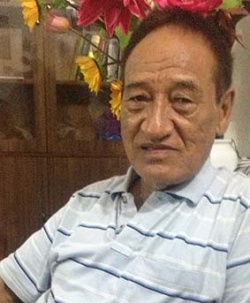Dr. Tashi Yangphel Tashigang
Dr. Tashi Yangphel Tashigang was born in a family of physicians in Nimo, Ladakh, India, in 1938. He started learning Tibetan medicine from his father and later from Ven. Sonam Norbu Lharje, and although he practiced medicine for some time, his great wish was to go to Tibet to further his studies. In 1956, at the age of 18, he was able to fulfill his desire. He left his hometown and first went to Kalimpong (W.B.) India, the commercial route between India and Tibet, and then entered to Tibet. There, he lived in Lhasa with a Ladakhi man, and gradually joined the Lhasa Men-Tsee-Khang where he received teachings from Ven. Dr. Lamen Khyenrab Norbu (1883-1962), the founder of the Lhasa Men-Tsee-Khang. Unfortunately he was trapped in Lhasa during the Tibetan uprising against China in 1959 and got shot in his legs while he was returning home after his studies. In spite of the serious injury, he was able to go back to India that same year. Describing his feelings and thoughts of that time, Dr. Tashi said: "Three bullets have injured my legs, I have been bleeding immensely, pale and dry I have lost consciousness at some time, but I will not die. My time has not come yet, I will not let bullets take my life." Indeed he survived and healed from his wounds, but very few Tibetan doctors actually succeeded in escaping from Tibet at that time.
Dr. Tashi first worked at Dharamsala Men-Tsee-Khang in the Tibetan refugee community of Himachal Pradesh, India. Those were difficult years for Tibetan medicine, where life and work had to start all over again from the beginning in a new country. In 1968, he joined the US Library Congress office (USLC) in New Delhi as a Tibetan language specialist where he assisted and worked under E. Gene Smith's supervision, director of the Library office. His work was to research, acquire, and catalogue Tibetan Buddhist literature on Tibetan medicine, astrology, philosophy, religion, and various other texts that were collected from the Himalayan regions of Ladakh, Nepal, Sikkim, and Bhutan. Over all, Dr. Tashi worked for the USLC office in New Delhi for 17 years.
Once his position with the USLC ended, Dr. Tashi strongly felt the need and importance to set up an organization for Tibetan medicine that would preserve rare manuscripts and traditional practices. Thus he not only became a full time physician and pharmacologist, but he also created and directed the Institute of Tibetan Medicine. He set up and introduced Smanrtsis Sherig spendzod (medicine and astrology literature library) and published series of rare and popular books on Tibetan medicine (around 251 volumes), his work consisting in researching, collecting, cataloguing and editing material - valuable background history, and individual and contemporary information related to important books and authors. His work has thus become a great source of information in the scientific history of Tibetan medicine and for medical works of various writers and scholars.
Dr. Tashi has travelled to the USA, Europe, Tibet (TAR), China, to give lectures, conferences, and teachings. He has also been involved in various researches with western counterparts in the fields of Tibetan medicine and new emerging sciences. Well respected in Tibet and China, Dr. Tashi is nowadays one of the only guardians of rare books still alive. Presently, he is an active member of the scientific Advisory Committee (Ay.) of the Central Council for Research in Ayurveda and Siddha in India.
During the summer of 2013, I had the possibility to visit Dr. Tashi and meet again this friend I had not seen in years. During this long meeting we had the opportunity to discuss a wide range of topics related to Tibetan medical history, literature and publications, but also about Medicine Buddha Bhaisajyaguruvaiduryaprabha (Sang rgyas smanbla bedurya). He then showed me the catalogue of the Potala, which describes a temple of the seven medicine Buddhas. Unfortunately as I didn't have any knowledge of the existence of such temple, I did not have the chance to visit it during my trips in Tibet in 2004 and 2008.
My respect for Dr. Tashi's work and dedication is immense. Thanks to his courage and devotion he has earned his name and fame among the intellectual society, and scholars respect him as being a Jewel of the Jewel. His work was a source of light for Tibetan medicine in the 1970s to 1990s when there was a lack of books available. He has done extensive scientific research and created large collections gathered from Tibet, Bhutan, Mongolia, and the Indian Himalayan states on ancient and rare literature going from history, medical practice, pharmacy, to Amchis (doctors) biographies.
However, I slightly feel that Tibetan Medicine or Sowa Rigpa community has not yet fully understood his valuable work and contribution to Tibetan medicine.
It would not be an exaggeration for me to put his name next to E. Gene Smith. Dr. Tashi's work has revived Tibetan medicine in India and given a chance to the seeker to fulfill its quest for knowledge. He has made large distributions to world libraries of his publications, and contributions to Tibetan libraries, as well as to the Tibetan Autonomous Region (TAR) Libraries for the preservation of Tibetan medicine. He received the ‘Yuthok Award’ at the Tibetan medicine congress held in Lhasa in 2003 organized by the Chinese, and he is well known in Tibet and China.
Presently, Dr. Tashi runs his institute and clinic in Delhi, and continues to publish rare and important books. Dr. Tashi embodies a treasure of information contained in a precious box-library. He lives healthy with his wife and is truly a Great Spirit.
